Doug Cook's Blog, page 32
August 16, 2012
Master Cook interviewed by Univision for article on Taekwondo in the Olympics
Taekwondo star siblings Steven and Diana Lopez are poised to take home the gold
By CYNTHIA MARTINEZ
Four years ago, the Lopez family was America’s best-known Taekwondo contenders in the 2008 Beijing Olympics. Not since 1904 had three siblings competed in the Olympic Games for a team, even less for one sport. The Texas brothers and sister were thus knighted as “The First Family of Taekwondo.” Steven and Diana both took home bronze, while Mark snatched up a silver medal. Big brother Jean served as the anchor and coach.Although Mark didn’t qualify for London 2012 (he lost his spot to rookie Terrance Jennings, 26) this won’t stop the dynamic duo of Steven and Diana, with big brother Jean once again holding down the coach’s chair making the team a triple threat.
 The four Lopez siblings and their parents with Don FranciscoThe Lopez family are first generation Latinos. In the early 1970’s, parents Julio and Ondina Lopez migrated to the United States from their native Nicaragua escaping political turmoil. Julio, a structural engineer back home, found work in a clothing factory that manufactured Yankees clothing. Julio’s love for martial arts films led him to enroll eldest Jean into Taekwondo, with Steven following suit. Soon thereafter, the family garage was a training gym. Now the Lopez family runs their own Taekwondo academy in their home of Sugarland, Texas, a suburb outside of Houston. Diana is the youngest and only girl. Her indomitable and fearless spirit comes from her mother, Ondina, who has been known to not have finger nails because of all the nerves that come from her children competing in such an intensive contact sport.
The four Lopez siblings and their parents with Don FranciscoThe Lopez family are first generation Latinos. In the early 1970’s, parents Julio and Ondina Lopez migrated to the United States from their native Nicaragua escaping political turmoil. Julio, a structural engineer back home, found work in a clothing factory that manufactured Yankees clothing. Julio’s love for martial arts films led him to enroll eldest Jean into Taekwondo, with Steven following suit. Soon thereafter, the family garage was a training gym. Now the Lopez family runs their own Taekwondo academy in their home of Sugarland, Texas, a suburb outside of Houston. Diana is the youngest and only girl. Her indomitable and fearless spirit comes from her mother, Ondina, who has been known to not have finger nails because of all the nerves that come from her children competing in such an intensive contact sport.
Read entire article
By CYNTHIA MARTINEZ
Four years ago, the Lopez family was America’s best-known Taekwondo contenders in the 2008 Beijing Olympics. Not since 1904 had three siblings competed in the Olympic Games for a team, even less for one sport. The Texas brothers and sister were thus knighted as “The First Family of Taekwondo.” Steven and Diana both took home bronze, while Mark snatched up a silver medal. Big brother Jean served as the anchor and coach.Although Mark didn’t qualify for London 2012 (he lost his spot to rookie Terrance Jennings, 26) this won’t stop the dynamic duo of Steven and Diana, with big brother Jean once again holding down the coach’s chair making the team a triple threat.
 The four Lopez siblings and their parents with Don FranciscoThe Lopez family are first generation Latinos. In the early 1970’s, parents Julio and Ondina Lopez migrated to the United States from their native Nicaragua escaping political turmoil. Julio, a structural engineer back home, found work in a clothing factory that manufactured Yankees clothing. Julio’s love for martial arts films led him to enroll eldest Jean into Taekwondo, with Steven following suit. Soon thereafter, the family garage was a training gym. Now the Lopez family runs their own Taekwondo academy in their home of Sugarland, Texas, a suburb outside of Houston. Diana is the youngest and only girl. Her indomitable and fearless spirit comes from her mother, Ondina, who has been known to not have finger nails because of all the nerves that come from her children competing in such an intensive contact sport.
The four Lopez siblings and their parents with Don FranciscoThe Lopez family are first generation Latinos. In the early 1970’s, parents Julio and Ondina Lopez migrated to the United States from their native Nicaragua escaping political turmoil. Julio, a structural engineer back home, found work in a clothing factory that manufactured Yankees clothing. Julio’s love for martial arts films led him to enroll eldest Jean into Taekwondo, with Steven following suit. Soon thereafter, the family garage was a training gym. Now the Lopez family runs their own Taekwondo academy in their home of Sugarland, Texas, a suburb outside of Houston. Diana is the youngest and only girl. Her indomitable and fearless spirit comes from her mother, Ondina, who has been known to not have finger nails because of all the nerves that come from her children competing in such an intensive contact sport.Read entire article
Published on August 16, 2012 09:18
August 6, 2012
Chosun e-newsletter Archive volumn #3 August 2012
Dojang News and Events
2012 Chosun Taekwondo Academy Korea Training and Cultural Tour
Saturday July 7 - Saturday July 14, 2012
The 2012 tour was another unbridled success. Tedanhi
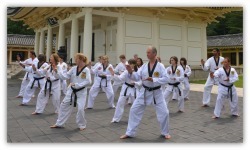 Kamsahamnida to all tour participants, family members, friends and fellow students at home who followed us online! It is not too early to consider making a dream come true in two years by reserving your place on the
2014 Chosun Korea Training & Cultural Tour.
Kamsahamnida to all tour participants, family members, friends and fellow students at home who followed us online! It is not too early to consider making a dream come true in two years by reserving your place on the
2014 Chosun Korea Training & Cultural Tour.
If you missed the Korea Travelogue, click on the site below for photos, maps, stories and more from the 2012 Chosun Korea Training & Cultural Tour. Subscribe to receive more updates and photos as they are added.
2012 Chosun Korea Tour Travelogue
Read entire newsletter
2012 Chosun Taekwondo Academy Korea Training and Cultural Tour
Saturday July 7 - Saturday July 14, 2012
The 2012 tour was another unbridled success. Tedanhi
 Kamsahamnida to all tour participants, family members, friends and fellow students at home who followed us online! It is not too early to consider making a dream come true in two years by reserving your place on the
2014 Chosun Korea Training & Cultural Tour.
Kamsahamnida to all tour participants, family members, friends and fellow students at home who followed us online! It is not too early to consider making a dream come true in two years by reserving your place on the
2014 Chosun Korea Training & Cultural Tour.
If you missed the Korea Travelogue, click on the site below for photos, maps, stories and more from the 2012 Chosun Korea Training & Cultural Tour. Subscribe to receive more updates and photos as they are added.
2012 Chosun Korea Tour Travelogue
Read entire newsletter
Published on August 06, 2012 09:49
Chosun e-newsletter Archive Volumn #3 July 2012
Photo Shoot for new YMAA book by GM Richard Chun and Master Doug Cook
 Monday June 18, 2012
Monday June 18, 2012
Fort Lee, NJGrandmaster Richard Chun, Master Doug Cook and Master Fred Kouefati met for an extensive one-day photo shoot that would yield vibrant illustrations for the soon-to-be-published book Taekwondo Black Belt Poomsae: Original Koryo & Koryo, offered by YMAA Publications of Boston. With a release date of autumn 2013, the prime subject of the work as the title denotes, revolves around two Korean-based poomsae, or formal exercises as they are generically known.
(excerpt from upcoming article, A Photo Shoot for the Ages by Master Doug Cook)
Click image for more photos
Read entire newsletter
 Monday June 18, 2012
Monday June 18, 2012 Fort Lee, NJGrandmaster Richard Chun, Master Doug Cook and Master Fred Kouefati met for an extensive one-day photo shoot that would yield vibrant illustrations for the soon-to-be-published book Taekwondo Black Belt Poomsae: Original Koryo & Koryo, offered by YMAA Publications of Boston. With a release date of autumn 2013, the prime subject of the work as the title denotes, revolves around two Korean-based poomsae, or formal exercises as they are generically known.
(excerpt from upcoming article, A Photo Shoot for the Ages by Master Doug Cook)
Click image for more photos
Read entire newsletter
Published on August 06, 2012 09:41
June 21, 2012
June 4, 2012
Chosun e-Newsletter Archive Volumn 3 #6 June, 2012
Dojang News and Events
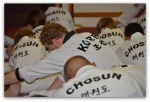 May 20, 2012
May 20, 2012
Chosun Belt Promotion Test
Almost 100 students participated in the recent Chosun Belt Promotion Test.
From white to black belt, students demonstrated the proficiency, spirit and respect of true martial artists. Highlights of the day included some unforgettable breaks by Chosun Black Belt students. Among them were speed breaks, a head break and a double jumping break. Congratulations to all Chosun students.
Read entire newsletter
 May 20, 2012
May 20, 2012Chosun Belt Promotion Test
Almost 100 students participated in the recent Chosun Belt Promotion Test.
From white to black belt, students demonstrated the proficiency, spirit and respect of true martial artists. Highlights of the day included some unforgettable breaks by Chosun Black Belt students. Among them were speed breaks, a head break and a double jumping break. Congratulations to all Chosun students.
Read entire newsletter
Published on June 04, 2012 12:57
May 7, 2012
Master Doug Cook interview on WTBQ Radio with Warwick, NY Supervisor Michael Sweeton
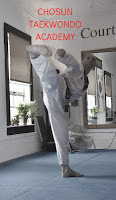 Master Doug Cook and his wife Patty talk about their 15 years of owning and operating the Chosun Taekwondo Academy in Warwick, NY. Master Cook defines the Korean martial art of Taekwondo and discusses why the academy has been such a successful and gratifying business and life calling. Also featured are Chosun workshops for the public,the yoga program, community outreach and Korea training tours.
Master Doug Cook and his wife Patty talk about their 15 years of owning and operating the Chosun Taekwondo Academy in Warwick, NY. Master Cook defines the Korean martial art of Taekwondo and discusses why the academy has been such a successful and gratifying business and life calling. Also featured are Chosun workshops for the public,the yoga program, community outreach and Korea training tours.Master Doug Cook interview on WTBQ Radio with Warwick, NY Supervisor Michael Sweeton
Published on May 07, 2012 15:52
May 1, 2012
Chosun e-newsletter archive Volumn 3 #5 May 2012
Dojang News and Events
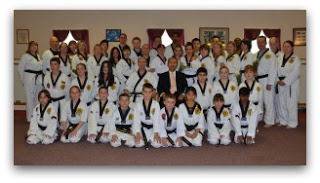 April 14 and 15, 2012
April 14 and 15, 2012
Chosun Black Belt Promotion Test
The much anticipated event finally arrived and the Chosun Black Belt candidates rose to the challenge. Not only the largest black best testing event ever hosted by the school, it was significant because Black Belt instructor Terri Testa advanced to the rank of master, 4th Dan. Chosun also added 13 new first dans, 6 new 2nd dans, and 5 new 3rd dans. Grandmaster Richard Chun was present on Saturday to officiate and commented on our school " as one of the best schools in the area and Master Cook one of the best instructors" Congratulations to all new Black Belts and thanks to all instructors and students for your continued support of Chosun.
Read entire newsletter

 April 14 and 15, 2012
April 14 and 15, 2012Chosun Black Belt Promotion Test
The much anticipated event finally arrived and the Chosun Black Belt candidates rose to the challenge. Not only the largest black best testing event ever hosted by the school, it was significant because Black Belt instructor Terri Testa advanced to the rank of master, 4th Dan. Chosun also added 13 new first dans, 6 new 2nd dans, and 5 new 3rd dans. Grandmaster Richard Chun was present on Saturday to officiate and commented on our school " as one of the best schools in the area and Master Cook one of the best instructors" Congratulations to all new Black Belts and thanks to all instructors and students for your continued support of Chosun.
Read entire newsletter
Published on May 01, 2012 12:18
April 13, 2012
Revelations by Master Doug Cook
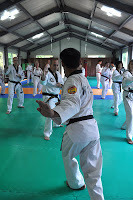 Not long ago, I was reviewing poomsae with a group of senior black belts, 3rd dan and up. One in particular had been performing an advanced, traditional form for many months. During the class, I interrupted her to suggest a modification in stance. After politely allowing me to finish my comment, the student asked if the motion had been changed from the time it had first been demonstrated to her. “No”, I replied, “you are simply more prepared now to receive a detailed explanation of this poomsae along with its purpose and intent.” I then went on to make what appeared to be a minor correction, albeit one that significantly improved her understanding of the form overall. My grandmaster does the same to me even now. Yet rather than question his action, I smile and think how fortunate I am to be drilling down even deeper, to the heart of a poomsae for instance, in the hope of revealing the very essence of tae kwon do doctrine. And so the cycle continues as it has from the beginning, from venerated master to worthy disciple, over the course of centuries.
Not long ago, I was reviewing poomsae with a group of senior black belts, 3rd dan and up. One in particular had been performing an advanced, traditional form for many months. During the class, I interrupted her to suggest a modification in stance. After politely allowing me to finish my comment, the student asked if the motion had been changed from the time it had first been demonstrated to her. “No”, I replied, “you are simply more prepared now to receive a detailed explanation of this poomsae along with its purpose and intent.” I then went on to make what appeared to be a minor correction, albeit one that significantly improved her understanding of the form overall. My grandmaster does the same to me even now. Yet rather than question his action, I smile and think how fortunate I am to be drilling down even deeper, to the heart of a poomsae for instance, in the hope of revealing the very essence of tae kwon do doctrine. And so the cycle continues as it has from the beginning, from venerated master to worthy disciple, over the course of centuries. Improvements, refinements and, ultimately, revelations are all fundamental conditions of meaningful, traditional tae kwon do training. These progressive states of learning apply not only to the novice, but even more so to the advanced practitioner. Adjustments to basic technique, poomsae, hyung or tul, self-defense and sparring, should be considered a pathway to perfection rather than a road to confusion and its accompanied stress. In the end, if embraced with an open mind, modifications chisel away at superfluous movement resulting in a profound sense of enlightenment signaled by a heightened stage of proficiency.
It can be said that tae kwon do is taught most effectively through a series of ever-diminishing circles with the outermost shell representing the most elementary understanding of a technique. Subsequently, each successive circle brings the practitioner increasingly closer to the technique’s core. This arduous, yet fulfilling process, requires great patience and humility; humility in the sense that the worthy student must not view a modification merely as a change indiscriminately propagated at the whim of a careless instructor, but rather as a stepping stone on a long path to excellence; a reward earned through diligent, mindful practice. To the curious Western mind, this process of distillation is often difficult to grasp. Customarily, we are not content with unexplained actions but frequently require detailed, verbal clarification with a focus on finality in almost everything we do. Yet, in Asian martial culture, partially in terms of Confucian philosophy, training without question is common; accepting technical refinements with gratitude rather than query is the norm.
To better understand this concept let us examine for a moment the procedure for teaching the jab/reverse punch. First, a proper fist must be formed; a structure a great majority of beginners are clearly unfamiliar with. Then, a stable platform or stance from which to execute this combination must be developed. Finally, efficient use of body mechanics needs to be explained. Most instructors I have had the honor of working with go to great extremes to clarify this formula, all the while realizing that the novice can assimilate only so much information in a given session. Yet, undoubtedly, the white belt in the formative stages of training barely scratches the surface of this skill. Frequent refinements are made until, rather than merely throwing out the hands, the student, at some future point in time, automatically assumes a sturdy defense stance, begins to pivot the hips, focuses on penetrating the target, executes the combination, and further amplifies the strikes with ki (internal energy) and confidence. If this process proceeds without the instructor constructively correcting the technique in compounded phases, increasing the practitioner’s proximity to the kernel of the technique and thus experiencing a catharsis of sorts begins to slip away.Nevertheless, the principle of enlightenment through revelations attached to ever-diminishing circles is nowhere more evident than in poomsae training. In times past, instruction in Korean poomsae, Japanese kata, or Chinese taolu, was often limited to four or five forms over the course of the martial artist’s entire lifetime giving the practitioner ample opportunity to learn the required motions correctly and in great detail, going deep rather than wide. In fact, great masters historically recommended learning poomsae Sip Soo (ten hands) for the power and speed it generates, Chulki Cho Dan (iron horse) for building a competent horse stance, and, in the case of karate-do, Sanchin kata (three battles), for internal and external strength, to the exclusion of all others. This concept has profound implications when viewed through the lens of the offensive and defensive possibilities embedded within formal exercises. The practical applications, bunkai in Japanese or hae sul as Master Stuart Anslow explains it, can be interpreted in any number of ways dependent upon the martial wisdom of the teacher in tandem with a supreme willingness on the part of the student to learn. Consequently, it would be virtually impossible to demonstrate each component of a poomsae within the scope of a single training session or even a year’s worth of classes for that matter. Bit by bit excessive movement is chipped away, refinements are polished, and hidden techniques are revealed that principally must be viewed as revelations rather than indiscriminate changes.At the culmination of class, traditional tae kwon do schools everywhere frequently recite a student oath. Ours includes a principle that represents a central pillar of martial arts philosophy: establish trust between teacher and student. In satisfying this standard, it is the teacher’s responsibility to transmit traditional, pure-form tae kwon do skills on to others worthy of the art, unblemished by personal preference. The competent instructor must execute this mission in a manner that satisfies the spirit and well as the mind and body, particularly in the case of poomsae, hyung or tul. If a technique is taught before the spirit is prepared to accept it in its fullness, it will be, at best, misunderstood or, at worst, taken for granted, diminished, and potentially abused. By the same token, it is the student’s obligation to absorb technical attributes with an open mind, a degree at a time, with a vengeance, until the true heart of the skill is revealed. If these gradual enhancements are viewed as refinements rather than changes in routine, then an authentic accumulation of knowledge will occur. If not, the questioning mind will eclipse the potential for enlightenment through the revelation of meaningful martial doctrine and technique.
Published on April 13, 2012 14:45
April 2, 2012
Chosun e-newsletter archive Volumn 3 #4 April, 2012
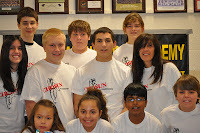 Chosun celebrating 15 years in the
Chosun celebrating 15 years in the village of Warwick
Leadership Team News
The Chosun Leadership Team's first fundraising event of the year was a great success. Proceeds will be donated to the Brian Ahearn Childrens Fund. Many thanks to team members, directors and parents for their hard work and support.
(Check out the NEW Leadership T-shirts designed by Chosun student and fine artist Catherine Pierson-DeCesare)
Don't miss the upcoming:
Annual Chosun Leadership Team Book & Bake Sale
Saturday April 28 (Springfest) 10:00am - 5:00pm and Sunday April 29 11:00am - 4:00pm, Lewis Park Main Street, Warwick. Proceeds benefit the Warwick Lions Club Holiday Party for Community Children in Need.
Read entire newsletter
Published on April 02, 2012 15:42
March 8, 2012
How Taekwondo Improved My Physical Fitness
by Mary Sudul, Chosun Black Belt Instructor
appears in TaeKwonDo Times Magazine
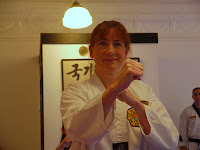 When I first walked into the Chosun Taekwondo Academy dojang in February of 2009, I was a typical middle-aged, overweight, sedentary woman with a standard American diet. I had been athletic as a teenager and young adult, but work, children, and home had come to take up all of my time. For a long time I used the usual excuse of "I don't have TIME to exercise." I also really didn't like exercising, it's such a sweaty thing to do! So I found myself at age 45 living in an unhealthy, unfit body, about 15 pounds overweight. Walking into the dojang turned out to be the best thing I could do for my physical health.
When I first walked into the Chosun Taekwondo Academy dojang in February of 2009, I was a typical middle-aged, overweight, sedentary woman with a standard American diet. I had been athletic as a teenager and young adult, but work, children, and home had come to take up all of my time. For a long time I used the usual excuse of "I don't have TIME to exercise." I also really didn't like exercising, it's such a sweaty thing to do! So I found myself at age 45 living in an unhealthy, unfit body, about 15 pounds overweight. Walking into the dojang turned out to be the best thing I could do for my physical health.
I began slowly, as all white belts do, though I threw myself whole-heartedly into my training. My 6th Dan Master, Doug Cook, offers classes nearly throughout the day and I am able to take advantage of numerous daytime classes while my children are at school. I try to train a minimum of 4 classes per week and frequently train more often than that. Taekwondo became a pursuit that I happily MAKE the time for even though I sweat.
I didn't want to over-tax myself in the beginning and end up burning out and quitting. So while I did push myself, I tried to be aware of my limitations at all times to avoid too much muscle soreness and injury. One of my main challenges is a lack of flexibility. Though my upper body can be fairly loose, my leg muscles and tendons always seem to be tight. Master Cook begins every class with a comprehensive stretching regime that takes about 20 minutes. I notice a big difference in my flexibility because of this. I will never be able to do a split, but my side kicks are getting higher and higher.
Despite my care, I did suffer a few minor injuries in my early months of training. I clearly remember one Saturday morning class when I was a green belt, I landed awkwardly after a jumping round kick and my knee twisted and buckled under me. I was carried off the floor that day. Luckily, no serious damage was done, but it took more than six months before I felt comfortable trying that kick again.
I feel that the most effective way to improve your fitness in the martial arts is to put 100% into your technique. The tighter you make your fist, the stronger and faster you attempt to perform your strikes and your kicks, the stronger and fitter your muscles become. The more intensity you put into your forms and your sparring, the more aerobically fit your body becomes. The more careful you are to perform your techniques correctly, the more coordinated you become. It is a slow transformation, but one day I noticed that I looked, felt, and performed better than I had since my 20's. Sometimes I just look at my hand making a fist and notice the definition of the muscles in my hand and lower arm. As for weight loss, well, I did lose about 10 pounds at the very beginning of my training, but little by little over the next year and a half most of that weight came back. Starting in March of 2011, I cut all grains, dairy, legumes, and sugar from my diet. It's actually easier than it sounds, and the cravings for these items disappeared after a couple of weeks. I lost 20 more pounds in two months and have kept it off so far, putting me well into the normal weight range for my height. Taekwondo gives me the life discipline to maintain this diet, and I love being able to perform the skills with less stress on my body. This diet and the accompanying weight loss have improved my muscular composition and definition.There is plenty of room for improvement still, but as I prepare for my black belt test in October 2011 at age 48, I feel like a new woman, a much fitter woman.

appears in TaeKwonDo Times Magazine
 When I first walked into the Chosun Taekwondo Academy dojang in February of 2009, I was a typical middle-aged, overweight, sedentary woman with a standard American diet. I had been athletic as a teenager and young adult, but work, children, and home had come to take up all of my time. For a long time I used the usual excuse of "I don't have TIME to exercise." I also really didn't like exercising, it's such a sweaty thing to do! So I found myself at age 45 living in an unhealthy, unfit body, about 15 pounds overweight. Walking into the dojang turned out to be the best thing I could do for my physical health.
When I first walked into the Chosun Taekwondo Academy dojang in February of 2009, I was a typical middle-aged, overweight, sedentary woman with a standard American diet. I had been athletic as a teenager and young adult, but work, children, and home had come to take up all of my time. For a long time I used the usual excuse of "I don't have TIME to exercise." I also really didn't like exercising, it's such a sweaty thing to do! So I found myself at age 45 living in an unhealthy, unfit body, about 15 pounds overweight. Walking into the dojang turned out to be the best thing I could do for my physical health.I began slowly, as all white belts do, though I threw myself whole-heartedly into my training. My 6th Dan Master, Doug Cook, offers classes nearly throughout the day and I am able to take advantage of numerous daytime classes while my children are at school. I try to train a minimum of 4 classes per week and frequently train more often than that. Taekwondo became a pursuit that I happily MAKE the time for even though I sweat.
I didn't want to over-tax myself in the beginning and end up burning out and quitting. So while I did push myself, I tried to be aware of my limitations at all times to avoid too much muscle soreness and injury. One of my main challenges is a lack of flexibility. Though my upper body can be fairly loose, my leg muscles and tendons always seem to be tight. Master Cook begins every class with a comprehensive stretching regime that takes about 20 minutes. I notice a big difference in my flexibility because of this. I will never be able to do a split, but my side kicks are getting higher and higher.
Despite my care, I did suffer a few minor injuries in my early months of training. I clearly remember one Saturday morning class when I was a green belt, I landed awkwardly after a jumping round kick and my knee twisted and buckled under me. I was carried off the floor that day. Luckily, no serious damage was done, but it took more than six months before I felt comfortable trying that kick again.
I feel that the most effective way to improve your fitness in the martial arts is to put 100% into your technique. The tighter you make your fist, the stronger and faster you attempt to perform your strikes and your kicks, the stronger and fitter your muscles become. The more intensity you put into your forms and your sparring, the more aerobically fit your body becomes. The more careful you are to perform your techniques correctly, the more coordinated you become. It is a slow transformation, but one day I noticed that I looked, felt, and performed better than I had since my 20's. Sometimes I just look at my hand making a fist and notice the definition of the muscles in my hand and lower arm. As for weight loss, well, I did lose about 10 pounds at the very beginning of my training, but little by little over the next year and a half most of that weight came back. Starting in March of 2011, I cut all grains, dairy, legumes, and sugar from my diet. It's actually easier than it sounds, and the cravings for these items disappeared after a couple of weeks. I lost 20 more pounds in two months and have kept it off so far, putting me well into the normal weight range for my height. Taekwondo gives me the life discipline to maintain this diet, and I love being able to perform the skills with less stress on my body. This diet and the accompanying weight loss have improved my muscular composition and definition.There is plenty of room for improvement still, but as I prepare for my black belt test in October 2011 at age 48, I feel like a new woman, a much fitter woman.
Published on March 08, 2012 03:33



